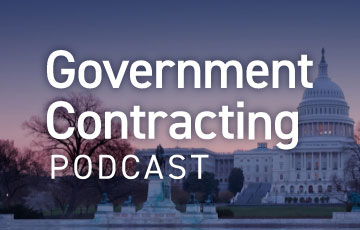Contributor: John Ford | Senior Consultant, Government Contractor Services
By law, the Defense Contract Audit Agency (“DCAA”) is required to submit an annual report to congress detailing DCAA’s activities for the previous year. On March 31, 2019, DCAA issued its report for 2018. As should be expected, the report is filled with numerous tables and charts containing “gee whiz” numbers. In this article, we will address some of those numbers and try to put them into some perspective.
For contractors, one of the most significant aspects of the report is DCAA’s assertion that it eliminated the incurred cost backlog, resulting in 8,482 incurred cost years closed, with a total dollar value of $392.2 billion. However, DCAA did not mention that this was largely due to changes in law requiring DCAA to complete an audit of an incurred cost proposal within 12 months of receipt of an adequate proposal. Also, most of these years were closed without DCAA conducting an audit because of DCAA’s adoption of a risk based approach to audits of Incurred Cost Submissions (“ICS”).
According to the report, DCAA examined $409 billion in contract costs, identified over $9.6 billion in audit exceptions, and reported $3.2 billion in net savings which is the amount of questioned costs sustained, minus the cost of performing the audits. DCAA trumpets the assertion that 2018 was the third year in a row in which it reported net savings of over $3 billion. However, 2018 was the second year in a row where net savings have declined. Further, the $3.2 billion in net savings is substantially lower than the $4.5 billion in net savings reported in 2014.
Net savings is significant to DCAA, as it generally tries to justify its existence and staffing levels by identifying the return on investment (“ROI”) that it provides to the Department of Defense (“DoD”). DCAA does not state how it computes the ROI. However, it appears it is calculated by dividing questioned costs sustained by contracting officers by the supposed cost of performing audits. Using this methodology, DCAA asserts that it provided DoD with a ROI of 5 to 1. Again, this is the second straight year of decline in this ROI and is a significant decline from the stated ROI of 7.3 to 1 in FY 2013.
This ROI is suspect for several reasons. First, we do not know if the cost of performing audits, as reported by DCAA, is accurate. DCAA should be called the Federal audit agency because it has memoranda of understanding with approximately 32 other agencies to do their contract audits. These audits are done on a reimbursable basis. It is not clear whether this reimbursable work is considered in determining the cost of performing audits and the savings that result from those audits. Next, the savings DCAA reports are based upon initial actions by contracting officers.
For example, if costs are questioned in an incurred cost audit and sustained by the contracting officer, DCAA appears to count those costs as savings to the government. However, if the contractor files a claim for the disallowed costs and the costs are subsequently allowed in total or in part, these allowances would not be reflected in the total savings because the allowances would likely occur in years after the report is submitted. Along these lines, the overwhelming amount of alleged cost saving occur in regard to forward pricing audits, primarily audits of proposals for new contracts. Of the $409 billion in reported total savings, $3.2 billion related to forward pricing audits. DCAA does not track these “savings” to determine if the contractor eventually recovers some of the “savings” during contract performance.
While on the subject of costs sustained, DCAA reported that total questioned costs sustained were 51% of questioned costs. Of these, the greatest percentage of questioned costs sustained related to forward pricing audits where 62% of questioned costs were sustained. Again, it is not clear how these figures were derived. It should be remembered that DCAA does not audit fee or profit in a proposal. However, if proposed costs are reduced during negotiations, fee or profit most certainly would also be reduced. It is not apparent how this is factored into total savings claimed by DCAA from the report.
While costs questioned in proposal audits should most accurately be described as costs avoided, costs questioned in an audit of actual costs clearly result in cost savings. In this regard, $2.1 billion of incurred cost audits accounted for the second largest category of audits performed by DCAA in FY 2018. They also accounted for the lowest sustention rate of 24%. Again, DCAA does not explain how it computes this rate. For example, we do not know if this represents the percentage of dollars disallowed on flexibly priced contracts or if this is the percentage of total questioned costs that were recovered.
It must be remembered that when DCAA does an incurred cost audit, the results are applied across all contracts, not just cost reimbursement contracts. Thus, questioned indirect costs that are sustained would have an impact on the costs allocated to firm fixed price contracts and the labor portion of T&M contracts, but without a reduction in what the government pays under those contracts.
Finally, the report addresses the time it takes DCAA to conduct an audit. For incurred cost audits, DCAA states that the average time to complete such audits in 2018 was 125 days. For these purposes, the time to complete an incurred cost audit is measured from the date of the entrance conference, not receipt of an adequate proposal, to report issuance. It must be remembered that by statute, DCAA’s right to conduct an incurred cost audit expires one year after receipt of an adequate proposal. However, there is still no Federal Acquisition Regulation (“FAR”) or Defense Federal Acquisition Regulation Supplement (“DFAR”) rule concerning the consequences of not meeting the one year standard.
Looking at forward pricing audits, DCAA states that the average time to complete such audits in 2018 was 85 days. This was up slightly from the 83 days it took to complete these audits in 2017, but substantially less than the 95 days it took in 2013. However, these times are substantially more than the 30 day target that was used prior to 2008, when the “brave new world” of audits was introduced. In measuring this completion time, DCAA says the clock starts when it receives the audit request or an adequate proposal until the audit report is issued.
As discussed above, while DCAA’s audit accomplishments may appear to be substantial, there are questions concerning the accuracy of the numbers reported. While we all agree that DCAA plays an important role in ultimately protecting the taxpayer, forgive us for being a little skeptical regarding some of the claims made.



